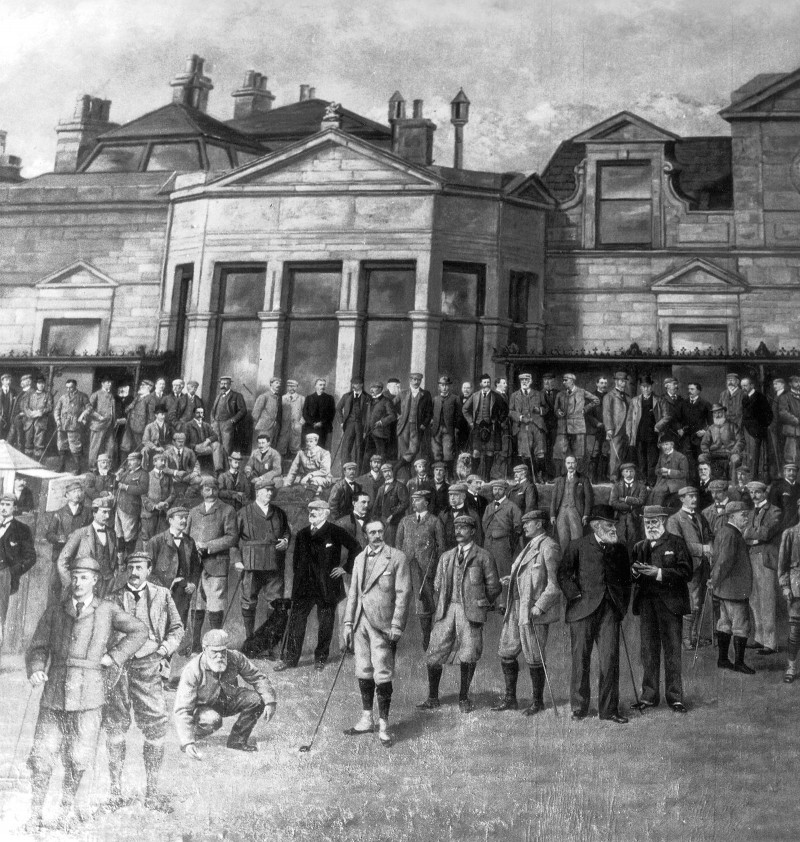

Aside from the two-week Christmas and New Year vacation period, professional golf is a non-stop, global, annual merry-go-round.
But four events each season—three in America, one in Great Britain—stand head and shoulders above the rest and shine like beacons during weeks when the sport’s leading players most hope to hit peak form.
These events are the Majors, and whole careers in professional golf are defined by them.

Ask Tiger Woods what record he most wants to eclipse and his answer would not require a moment’s thought—it is the 18 Major titles achieved by Jack Nicklaus between 1962 and 1986. Going into this season Woods was stuck on 14, but the pressure was on. His last victory in one of the ‘big four’ came in the 2008 U.S. Open at Torrey Pines.
Ask Colin Montgomerie what is the biggest regret of his 26 years as a tournament professional, a period during which he won eight European Tour order of merit titles and starred in eight Ryder Cup matches, and he would point immediately to the fact that he was five times a runner-up in Majors but never once a winner.
And if you were to ask Jean Van de Velde to nominate a hole he would like to play again, it would have to be the 18th at Carnoustie on the east coast of Scotland where, in 1999, he needed only a closing double-bogey six to win, somehow contrived to take seven and subsequently lost a play-off to local hero Paul Lawrie.
That came in the [British] Open, oldest of the quartet of modern-day Major championships with a history that dates back to 1860. The U.S. Open followed in 1895, the PGA Championship in 1916 and finally the Masters in 1934.
All four have grown into huge sporting spectacles, televised live around the world; but even though the basic playing structures are now identical—72 holes of stroke play stretched across four consecutive days, from Thursday to Sunday— each has had its own evolutionary process and to this day there are still fundamental differences.
The Open Championship began with a mere eight players taking part in a three-round, one-day competition on a 12-hole course
Take this for starters. the Open Championship began with a mere eight players taking part in a three-round, one-day competition on a 12-hole course at Prestwick on the west coast of Scotland in October, a time of year when the weather in that part of the world is generally far from clement.
Only later did 18 holes become the standard layout for golf courses and it was not until 1892 that the Championship became a two-day, 72-hole affair. It was first staged over three days in 1904— the number of entries by then had swelled to 144—and finally it was scheduled over four days from 1966 onwards.
By then it had become an established fixture on the British sporting calendar during the third week in July. Not that this move guaranteed good weather in Britain, of course; indeed, one Japanese journalist famously asked the question as the wind howled and the rain lashed down one year: “Why do you not hold the Open in summer?”

Being at the mercy of an unpredictable climate is part of the Open’s charm for many and certainly part of the very different test of golf it presents to the competitors than that faced most years at the other three Majors on the western side of the Atlantic.
The governing body, the R&A, have always staged it on a links course—that is, coastal stretches of land invariably set amid sand dunes where the wind provides the greatest defense. Of course, the relative difficulty of the venues on the roster— currently the Old Course at St Andrews, Muirfield, Carnoustie, Turnberry and Royal Troon in Scotland; Royal St. George’s (Sandwich), Royal Birkdale, Royal Liverpool (Hoylake) and Royal Lytham in England— is by and large dictated by the weather.

For example, Greg Norman won with a record low score at Sandwich in 1993 and on the same layout 10 years later Ben Curtis was the only player to finish under par.
In contrast, the Masters is always held at Augusta National in Georgia, and given that it is operated by the club itself there is no possibility of that ever changing.
Even though the original design of Augusta National owed more than just a passing nod to the Old Course at St Andrews, it is fair to say that there is generally very little resemblance between the wildness of [British] Open venues and the manicured magnificence of Bobby Jones’ pride and joy. In truth, Augusta National is a world apart from links golf and what is demanded of the players is vastly different too.
Its lack of rough, severely undulating fairways and greens, and risk-and-reward nature—water comes into play on five of the last eight holes— guarantees a dramatic finale to each round as the crowd’s cheers and sighs echo around the statuesque pines that fence in each hole.
From the players’ viewpoint, the Masters is also the toughest of the four Majors to qualify for. It has the smallest field, these days around 100 players, and entry to it is by invitation only.
However, there are now some strictly laid-down criteria with the world’s top 50, main tournament winners on the PGA Tour, top performers in the other Majors and some leading amateurs automatically earning places in the field alongside all the former champions. It has its unique traditions too.
A Par-3 competition is staged on the eve of the main event and the ceremony at the end culminates in the awarding of not a trophy, but a green jacket held by the previous year’s winner for the new champion to don in the fabled Butler’s Cabin.
The Masters is now also the only one of the Major quartet to have a sudden-death playoff in the event of a tie, perhaps because there is less daylight in early April than at the height of summer.
The [British] Open and PGA Championships have adopted playoffs over four and three extra holes respectively to determine the outcome, but the U.S. Open sticks rigidly to its long-held policy of requiring the players who have tied after 72 holes to return the following morning for a further 18 holes. If they are still tied, only then will the process revert to sudden-death.
The very title “Open” separates two of the four championships from the other two as regards their labyrinthine mechanisms for qualifying.
The United States Golf Association runs the U.S. Open and it holds a series of local and sectional qualifying tournaments throughout the country, and also in England and Japan, while the R&A spreads its wings even wider by offering chances in Europe, Australasia, South Africa, Asia and America at varying times during the year in addition to its regional, final and international qualifiers in Britain and Ireland.
The Professional Golfers’ Association of America is responsible for the PGA Championship and their field each year contains a minimum number of club professionals, although this figure was reduced from 40 to 25 in 1995 and then to 20 in 2006.
This reduction was in order to make room for more of the world’s better-known players and many argue that the championship now attracts the strongest field of all the four Majors, and thus in the whole of golf.
The PGA Championship began its life as a match-play contest and continued in that vein until 1958 when it fell in line with the other three Majors and adopted the standard 72-hole stroke-play format. Despite the excitement generated by head-to-head combat, its fickleness ran the risk of big names crashing out on the opening day, whereas stroke play tends to bring the cream rising to the top more, especially towards the latter stages—a highly important factor in an age dominated by TV ratings when golf is competing fiercely against numerous other sports for exposure.
The U.S. Open is historically known for being played on difficult courses that have narrow fairways, challenging greens and thick rough, thus placing a considerable premium on accuracy and a conservative approach to course management, although graduated rough and risk-reward options have been introduced with great success in recent years. The championship is rarely won with a score more than two or three shots under par, although Rory McIlroy break the record by four in 2011 with his 16-under total at Congressional.
As for the future, the return of golf to the Olympic Games in Rio de Janeiro, Brazil in 2016—after a gap of more than 100 years—will inevitably alter the game’s championship landscape, especially as more countries without much of a golfing pedigree are expected to take up the game with relish.
That is not to say the men’s golf tournament at the Olympics will instantly become a fifth Major—or a sixth in the case of the women’s game by then—but it may necessitate a change to the traditional mid-August date of the PGA Championship once every four years, and that in itself could have knock-on effects for other tournaments across the Tour schedules, perhaps even the recently introduced FedExCup playoffs.
However, as has been the case with the evolution of the four ‘Grand Slam’ tournaments in tennis over the past century, the big four events in golf, despite their marked differences, look set to remain the ‘big four’ as a collective package for the foreseeable future…
Follow Us On


| Cookie | Duration | Description |
|---|---|---|
| cookielawinfo-checkbox-analytics | 11 months | This cookie is set by GDPR Cookie Consent plugin. The cookie is used to store the user consent for the cookies in the category "Analytics". |
| cookielawinfo-checkbox-functional | 11 months | The cookie is set by GDPR cookie consent to record the user consent for the cookies in the category "Functional". |
| cookielawinfo-checkbox-necessary | 11 months | This cookie is set by GDPR Cookie Consent plugin. The cookies is used to store the user consent for the cookies in the category "Necessary". |
| cookielawinfo-checkbox-others | 11 months | This cookie is set by GDPR Cookie Consent plugin. The cookie is used to store the user consent for the cookies in the category "Other. |
| cookielawinfo-checkbox-performance | 11 months | This cookie is set by GDPR Cookie Consent plugin. The cookie is used to store the user consent for the cookies in the category "Performance". |
| viewed_cookie_policy | 11 months | The cookie is set by the GDPR Cookie Consent plugin and is used to store whether or not user has consented to the use of cookies. It does not store any personal data. |